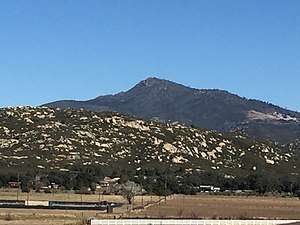Cuyamaca Peak
Cuyamaca Peak is a mountain peak of the Cuyamaca Mountains range, in San Diego County, Southern California.
| Cuyamaca Peak | |
|---|---|
 Cuyamaca Peak from the South | |
| Highest point | |
| Elevation | 6,515 ft (1,986 m) NAVD 88[1] |
| Prominence | 2,855 ft (870 m) [1] |
| Listing | Hundred Peaks Section[2] |
| Coordinates | 32°56′48″N 116°36′23″W [3] |
| Geography | |
| Location | San Diego County, California, U.S. |
| Parent range | Cuyamaca Mountains |
| Topo map | USGS Cuyamaca Peak |
| Climbing | |
| Easiest route | Hike, class 1[2] |
Geography
At 6,512 feet (1,985 m), its summit is the second highest point in San Diego County.
Cuyamaca Peak is located roughly 40 miles (64 km) from the Pacific Ocean, within Cuyamaca Rancho State Park. It is east of the city of San Diego and southwest of Julian.
A popular 3.5-mile (5.6 km) year round hike to the summit of Cuyamaca leads from the Paso Picacho Campground, starting at about 5,000 feet (1,500 m).
Ecology
Snows in winter are common above 5,000 feet (1,500 m) and surrounding regions in Cuyamaca Rancho State Park. During summer, Bracken Ferns, a variety of wildflowers and native bunchgrasses dominate mountain meadows and the forest floor. Prior to the Cedar Fire, Black oaks once lit up the mountain.
Cedar Fire
In October 2003, the Cedar Fire, the largest fire in recorded California history, burned the once abundant White Fir (Abies concolor), Incense Cedar (Calocedrus decurrens), Jeffrey Pine, Coulter Pine, Sugar Pine, and Black oak (Quercus kelloggii) that once lined the mountain.
Small seedlings of new White fir, Sugar Pine, Coulter Pine, Jeffrey Pine, and Incense Cedar were seen within a year of the Cedar Fire, and were thriving as saplings by 2007, an example of fire ecology.
Precipitation
The significant elevation of Cuyamaca relative to its surrounding landscape catches Pacific moisture easily, forming clouds which are forced to release their moisture in order to pass East, resulting in average annual precipitation between 20 and 32 inches. Fall and Winter storms account for 70%, summer thunderstorms largely accounting for the balance. During the winter snow may fall and hoar frost is common upon the highest elevations.
Views
On clear days visibility from the summit of Cuyamaca Peak can range from 60–100 miles (97–161 km) in nearly every direction.
To the west, the Pacific Ocean, the Coronado Islands of Mexico, the coast line of San Diego County, Viejas Mountain, and El Cajon Mountain can be seen.
Looking north, one can see 6,140-foot (1,870 m) Palomar Mountain among the ridge of Palomar Mountains. On very clear days 8,716-foot (2,657 m) Toro Peak in the Santa Rosas and the San Jacintos are visible. Closer yet is Volcan Mountain slightly to the northeast, the former gold rush town of Julian lying in front. Directly north are the closest summits, Middle and North Peaks.
Directly east is the Anza Borrego Desert and the Laguna Mountains, including Whale Peak. Far beyond is the Salton Sea. To the south are Lyons Peak and Lawson Peak; further yet and to the southeast are Mexican border mountains such as Table Top Mountain and the Sierra de Juárez.
Gallery
 View of Cuyamaca Peak from the east.
View of Cuyamaca Peak from the east. Just down from the Cuyamaca summit.
Just down from the Cuyamaca summit. Burned forest on the lower slopes of Cuyamaca.
Burned forest on the lower slopes of Cuyamaca. Forest nearing the summit.
Forest nearing the summit. White Firs near Cuyamaca's summit, deceased Bracken Ferns.
White Firs near Cuyamaca's summit, deceased Bracken Ferns. Typical Cuyamaca scene, White Firs, Granite, January snow.
Typical Cuyamaca scene, White Firs, Granite, January snow. View of Cuyamaca Peak from North Fortuna Mountain in San Diego.
View of Cuyamaca Peak from North Fortuna Mountain in San Diego. Cuyamaca Peak from Hot Springs Mountain
Cuyamaca Peak from Hot Springs Mountain
References
- "Cuyamaca Peak, California". Peakbagger.com. Retrieved 2009-01-25.
- "Cuyamaca Peak". Hundred Peaks Section List. Angeles Chapter, Sierra Club. Retrieved 2011-05-08.
- "Cuyamaca Peak". Geographic Names Information System. United States Geological Survey. Retrieved 2009-01-25.
External links
| Wikimedia Commons has media related to Cuyamaca Peak. |
- "Cuyamaca Rancho State Park". California State Parks. Retrieved 2011-05-08.
- "Cuyamaca Peak". SummitPost.org. Retrieved 2011-05-07.
- "Cuyamaca Webcam". CreekBed Websites. Retrieved 2011-05-08.